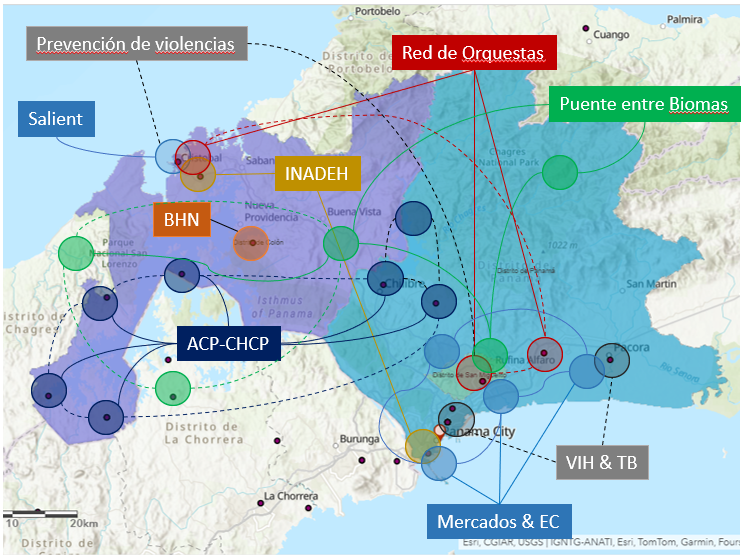Disclaimer:
Please be aware that the content herein has not been peer reviewed. It consists of personal reflections, insights, and learnings of the contributor(s). It may not be exhaustive, nor does it aim to be authoritative knowledge.
Learnings on your challenge
What are the top key insights you generated about your learning challenge during this Action Learning Plan? (Please list a maximum of 5 key insights)
Centralized Power Structures and the Move Toward Local Engagement:
Our focus on decentralizing power by engaging local municipalities has proven to be a key area for collective action. Municipalities have become strong partners, showing significant energy in embracing local engagement and systemic thinking. These regions offer fertile ground for transformative initiatives that can scale to national policies. By collaborating with key local actors and facilitating knowledge exchange between regions, we are seeing clear momentum in operationalizing this approach, ensuring that the portfolio interventions directly address local needs and are co-created with the community.
Strategic Partnerships and Citizen Participation are Key to Success:
We have identified that establishing strategic partnerships across government, academia, the private sector, and innovation ecosystems is crucial for driving the portfolio forward. Involving citizens in the design process through participatory methods has ensured that our interventions are grounded in the realities of the people we aim to serve. These partnerships and citizen engagement have created strong momentum, providing the necessary foundation to operationalize the portfolio. There is growing collective energy among these stakeholders to work together, aligning our interventions with both the needs of the country office and the broader community.
Digital Tools as Catalysts for Participation and Cohesion:
Our experimentation with digital tools, including AI, has demonstrated strong potential to increase participation and foster social cohesion. These tools have helped build trust among participants, suggesting momentum for integrating digital solutions into the portfolio process. However, the digital divide remains a significant barrier. To fully operationalize this, addressing these gaps is crucial, particularly by engaging stakeholders who can support the broader adoption of digital tools, ensuring they reach marginalized groups and enhance collective participation.
Social cohesion as a Concept and Its Key Dimensions:
Working with the Human Development Report team, we have framed social cohesion around three dimensions—inequalities, governance, and trust. This framework has generated shared understanding and a common narrative among stakeholders, allowing us to align efforts more effectively. By defining social cohesion in a way that resonates across sectors, we’ve built momentum in addressing this challenge. This shared framework is critical for driving collective action, as it enables us to approach the issue of social cohesion cohesively with both internal and external stakeholders.
Solid Waste Management and Circular Economy as a Shared Priority:
Solid waste management and the circular economy have emerged as areas of strong momentum for operationalizing the portfolio process. This issue resonates nationally and locally, providing a starting point for engaging municipalities and other stakeholders. By framing these challenges within a broader systemic approach—linking them to participation, transparency, and inclusive narratives—we have begun to co-create a shared vision for the future with local actors. This has led to meaningful collaboration, making it a key area where collective action is already underway, supported by both national and local stakeholders.
Considering the outcomes of this learning challenge, which of the following best describe the handover process? (Please select all that apply)
Our work has led to significant changes in our UNDP Country Office programming, Our work has not yet scaled
Can you provide more detail on your handover process?
Through the portfolio process, we chose social cohesion as a core topic for our country office to work on. This decision has led to our Human Development Report to have social cohesion as the storyline across the different papers that are being published, incorporating COs & the Labs cases. In addition, a Prospective Analysis (PAPEP) was conducted to understand future scenarios of social cohesion in Panama, with both processes (HDR/PAPEP) having a strong participation of senior management in its direction. Now, in the light of a new government period that is just beginning, poses a fertile opportunity to showcase a new value proposition that can be operationalized through the local government strategy for portfolios that we are implementing.
Please paste any link(s) to blog(s) or publication(s) that articulate the learnings on your frontier challenge.
Data and Methods
Relating to your types of data, why did you chose these? What gaps in available data were these addressing?
The sensemaking process in San Miguelito has enabled the understanding of key municipal challenges and gaps of resources, capabilities and alliances that we can support/bridge as UNDP – and proved to be an effective methodology to generated actionable insights.
The focus groups for the work on social cohesion in host communities of migrants; as well as the inter-generational learning spaces for social cohesion through artificial intelligence where able to collect valuable qualitative data and insights to understand social cohesion dynamics and key opportunities for action.
The pilot on inter-generational social cohesion through artificial intelligence generated quantitative insights and data that has been key to inform the portfolio process; as well as the Human Development Reports on digitalization and social cohesion.
Why was it necessary to apply the above innovation method on your frontier challenge? How did these help you to unpack the system?
The sensemaking and systems thinking process with the municipality of San Miguelito was a test that enabled the shared understanding of the reality of this local government among the UNDP senior management members that participated together with 8 directors of the municipality. The exercise showcased the relevance of a systemic approach to tackle the most pressing municipal challenges, and validated that social cohesion can be an end, but also a transformative force for change.
In addition, we are currently conducting a sensemaking to prioritize 2-3 municipalities to advance the portfolio process on social cohesion at a local level, where we will expand the use of the sensemaking and systems thinking methodology to new municipalities, which will seek to enable inter-municipal cross pollination on shared challenges (I.e.: solid waste management), with social cohesion at its core.
One of the key pilots that was tested was on artificial intelligence and intergenerational citizen participation, which enabled the co-creation of public spaces and alternative (desirable and non-desirable) futures in the face of climate change. There was a richness of insights generated from this exercise that can be consulted here:
Results AI workshop on Climate Resilience and Participation.pdf
Resultados de Talleres de Diseño Urbano Intergeneracional con Inteligencia Artificial UTP Mayo 2024.pdf
Partners
Please indicate what partners you have actually worked with for this learning challenge.
Please state the name of the partner:
Municipality of San Miguelito
What sector does your partner belong to?
Government (&related)
Please provide a brief description of the partnership.
Our partnership with local governments focuses on using sensemaking and systems thinking to address municipal challenges. In San Miguelito, a joint exercise with UNDP senior management and municipal directors demonstrated the value of a systemic approach and showed how social cohesion can drive transformation. We are now expanding this approach to 2-3 other municipalities, fostering inter-municipal collaboration on shared challenges like waste management.
Is this a new and unusual partner for UNDP?
Yes
End
Bonus question: How did the interplay of innovation methods, new forms of data and unusual partners enable you to learn & generate insights, that otherwise you would have not been able to achieve?
The interplay of innovation methods, new forms of data, and collaboration with unusual partners allowed us to uncover insights that would have been otherwise inaccessible. By employing sensemaking and systems thinking, we were able to tackle complex municipal challenges from a systemic perspective, while new forms of data—such as AI-driven citizen participation—provided a deeper, real-time understanding of local dynamics. Partnering with diverse, non-traditional stakeholders, including intergenerational groups, expanded our perspective, enabling us to co-create solutions and explore future scenarios in ways that traditional approaches could not achieve. This combination fostered richer insights, more inclusive problem-solving, and transformative social cohesion.
Please upload any further supporting evidence / documents / data you have produced on your frontier challenge that showcase your learnings.
The closing form saves automatically or via the blue "save changes" button the top left. Thank you


 10Reduced innequalities
10Reduced innequalities

 17Partnerships for the goals
17Partnerships for the goals
Comments
Log in to add a comment or reply.